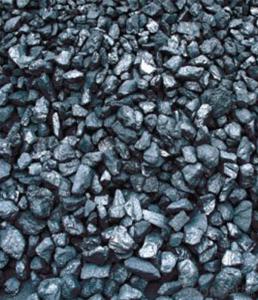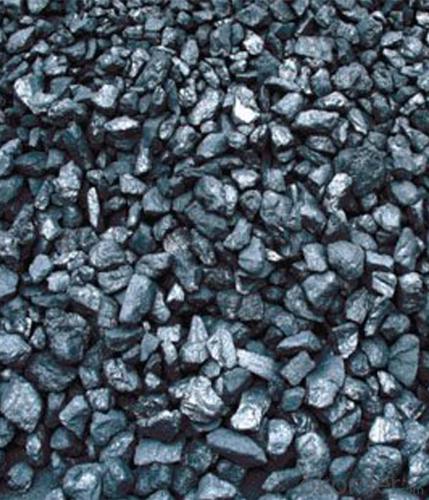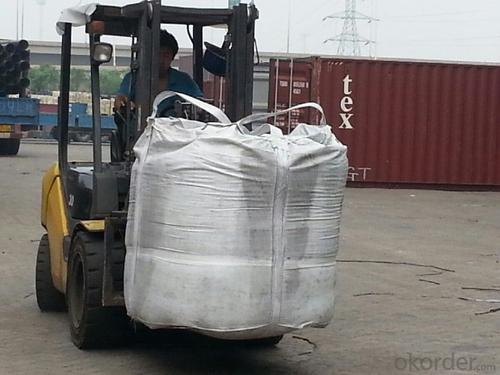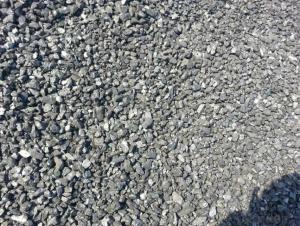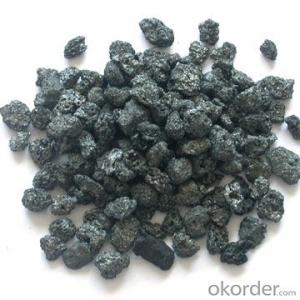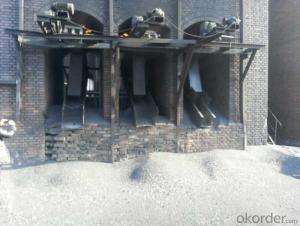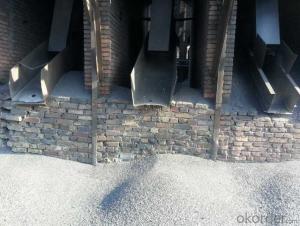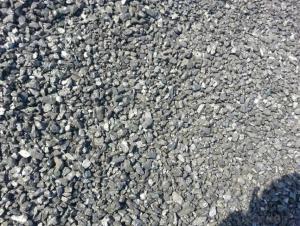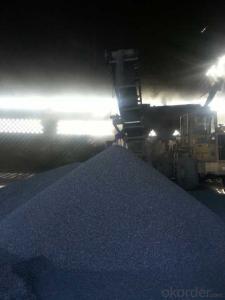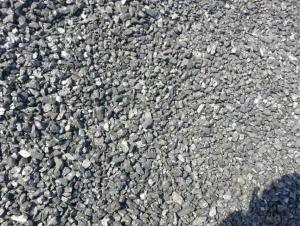Injection carbon FC92 with high and stable quality
- Loading Port:
- Tianjin
- Payment Terms:
- TT OR LC
- Min Order Qty:
- 20 m.t.
- Supply Capability:
- 3000 m.t./month
OKorder Service Pledge
OKorder Financial Service
You Might Also Like
Packaging & Delivery
25kgs/50kgs/1ton per bag or as buyer's request
Specifications
Calcined Anthracite
Fixed carbon: 90%-95%
S: 0.5% max
Size: 0-3. 3-5.3-15 or as request
It used the high quality anthracite as raw materials through high temperature calcined at over 2000 by the DC electric calciner with results in eliminating the moisture and volatile matter from anthracite efficiently, improving the density and the electric conductivity and strengthening the mechanical strength and anti-oxidation. It has good characteristics with low ash, low resistvity, low sulphur, high carbon and high density. It is the best material for high quality carbon products.
Advantage and competitive of caclined anthracite:
1. strong supply capability
2. fast transportation
3. lower and reasonable price for your reference
4.low sulphur, low ash
5.fixed carbon:95% -90%
6..sulphur:lower than 0.3%
General Specification of Calcined Anthracite:
| FC | 95 | 94 | 93 | 92 | 90 |
| ASH | 4 | 5 | 6 | 6.5 | 8.5 |
| V.M. | 1 | 1 | 1 | 1.5 | 1.5 |
| S | 0.3 | 0.3 | 0.3 | 0.35 | 0.35 |
| MOISTURE | 0.5 | 0.5 | 0.5 | 0.5 | 0.5 |
Pictures
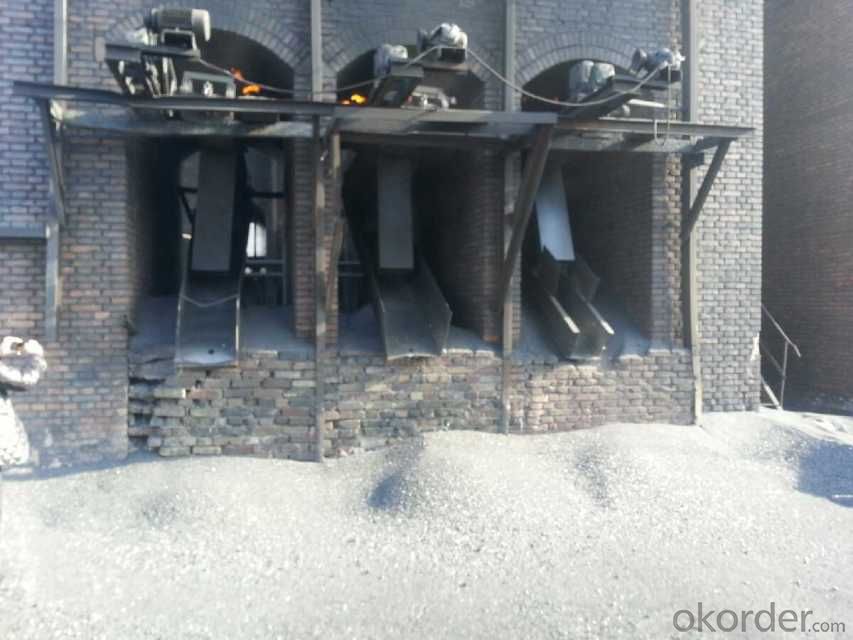
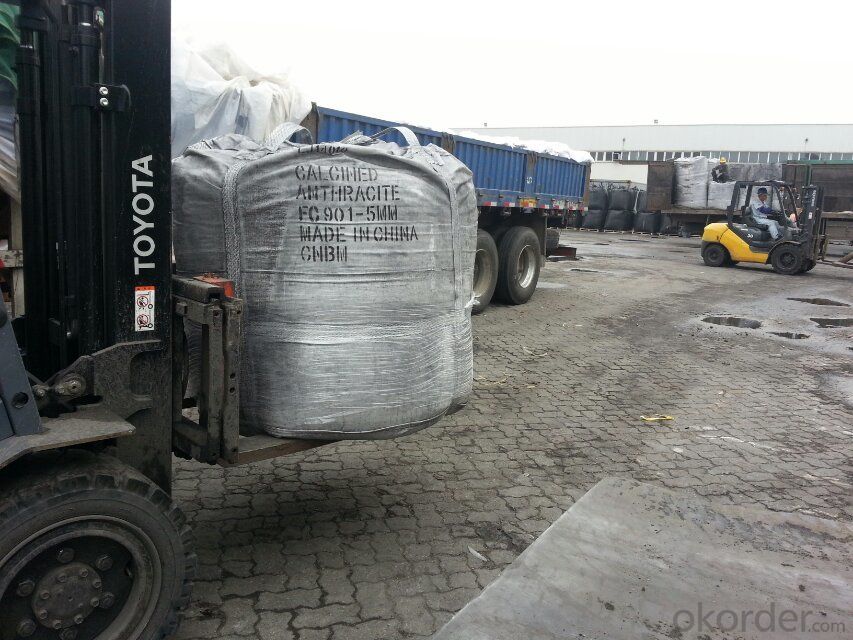
- Q: How does carbon affect water quality?
- Water quality can be affected both positively and negatively by carbon. On the positive side, carbon is a natural component of the carbon cycle and has a vital role in maintaining the equilibrium of aquatic ecosystems. It serves as a nutrient for aquatic plants, aiding their growth and providing nourishment and shelter for other organisms in the food chain. However, an excess of carbon in water can have adverse effects on water quality. One way this occurs is through the rise of dissolved organic carbon (DOC). Elevated levels of DOC can result from the decomposition of organic matter, such as deceased plants and animals, as well as the leaching of organic compounds from soil. These organic compounds can harm water quality by diminishing the amount of dissolved oxygen accessible to aquatic organisms, leading to asphyxiation of fish and other aquatic life. Moreover, high levels of carbon can contribute to eutrophication. Eutrophication takes place when there is an overflow of nutrients, including carbon, in water bodies, causing an excessive growth of algae and other aquatic plants. This excessive growth can deplete oxygen levels in the water as the plants decompose, causing harm to fish and other organisms that rely on oxygen for survival. Additionally, carbon can interact with other pollutants present in water, like heavy metals and pesticides, which can become more toxic and readily available when combined with carbon. This can have detrimental effects on aquatic organisms and disrupt the overall balance of the ecosystem. In conclusion, while carbon is vital for the functioning of aquatic ecosystems, excessive amounts can negatively impact water quality by reducing oxygen levels, promoting eutrophication, and increasing the toxicity of other pollutants. Therefore, it is crucial to monitor and manage carbon levels in water bodies to ensure the maintenance of a healthy and balanced aquatic ecosystem.
- Q: What is the difference in carbon content of low carbon steel, medium carbon steel and high carbon steel?
- Carbon content of low carbon steel (AISI1005 ~ 1026) is 0.06% to 0.28%, manganese content is 0.25% to 1%, phosphorus content is not more than 0.04%, sulfur content is not more than 0.05%.
- Q: How does carbon impact the prevalence of earthquakes?
- The prevalence of earthquakes is not directly influenced by carbon. Instead, earthquakes are primarily caused by the movement of tectonic plates, which are massive sections of the Earth's crust that float on the semi-fluid layer beneath. When these plates collide, slide past each other, or separate, seismic waves are released, resulting in an earthquake. On the other hand, carbon is a chemical element that exists in various forms in the Earth's atmosphere, oceans, and living organisms. Human activities, such as emitting carbon dioxide (CO2), contribute to climate change and impact the Earth's ecosystems. However, there is no direct connection between carbon emissions and the prevalence of earthquakes. Nevertheless, it is important to note that some geologists and scientists suggest that human activities, such as extracting fossil fuels, may indirectly affect seismic activity. The extraction of large quantities of oil, gas, or water from the Earth's crust can potentially alter underground pressure and stress distribution, potentially triggering induced earthquakes. These induced earthquakes are usually of low magnitude and limited to the specific extraction area. Overall, while carbon emissions and human activities may have some localized impact on seismic activity, the global prevalence of earthquakes is mainly driven by tectonic plate movements and is not directly influenced by carbon.
- Q: What are the effects of carbon emissions on the Arctic ecosystem?
- Carbon emissions have significant effects on the Arctic ecosystem, primarily due to the phenomenon of global warming. As carbon dioxide and other greenhouse gases are released into the atmosphere, they trap heat, leading to increased temperatures worldwide. However, the Arctic is particularly vulnerable to these effects due to its unique characteristics. One of the most significant impacts of carbon emissions on the Arctic ecosystem is the rapid melting of ice. Rising temperatures cause glaciers and ice sheets to shrink, leading to the loss of habitat for ice-dependent species such as polar bears, walruses, and seals. These animals not only rely on the ice for resting and breeding but also for hunting and finding food. With the reduction of their natural habitat, their populations are declining, impacting the delicate balance of the Arctic food chain. Additionally, the melting of ice results in rising sea levels, which can have cascading effects on coastal areas. Many Arctic communities, including indigenous peoples, are located near the coast and depend on the sea for their livelihoods. Increased erosion, flooding, and storm surges due to rising sea levels threaten their homes, infrastructure, and traditional ways of life. Furthermore, carbon emissions contribute to ocean acidification, a process in which the absorption of excess carbon dioxide by seawater leads to a decrease in its pH level. This acidification has detrimental effects on marine organisms such as shellfish, corals, and plankton, which struggle to build and maintain their calcium carbonate structures. These organisms are essential food sources for various Arctic species, including fish, seabirds, and marine mammals. The decline in their populations disrupts the intricate web of life in the Arctic and can have far-reaching consequences. Climate change caused by carbon emissions also disrupts the timing and patterns of seasonal events, such as the timing of plant growth, the migration of birds, and the availability of food resources. This mismatch can have severe consequences for species that rely on specific timing for reproduction, migration, and survival. Overall, the effects of carbon emissions on the Arctic ecosystem are profound and wide-ranging. The loss of sea ice, rising sea levels, ocean acidification, and disrupted ecological processes all contribute to the vulnerability of Arctic species and communities. Urgent action to reduce carbon emissions, mitigate climate change, and protect this fragile ecosystem is crucial for the long-term preservation of the Arctic.
- Q: What is carbon?
- Carbon is a chemical element that is essential for life on Earth. It is found in all living organisms and is the building block for the organic compounds that make up our bodies, such as proteins, carbohydrates, lipids, and nucleic acids. Carbon is also a key component of the Earth's atmosphere, where it exists mainly as carbon dioxide. It is present in various forms, including graphite and diamonds, and has the ability to form strong bonds with other elements, making it incredibly versatile. Carbon plays a crucial role in many natural processes, such as photosynthesis, respiration, and the carbon cycle, which helps regulate the Earth's climate. It is also widely used in industry, serving as a raw material for the production of fuels, plastics, and countless other products. Overall, carbon is a fundamental element that is vital for sustaining life and driving various chemical and biological processes.
- Q: What are the properties of carbon-based textiles?
- Carbon-based textiles have a number of unique properties that make them advantageous in various applications. Firstly, carbon-based textiles exhibit exceptional strength and durability. They are known for their high tensile strength, making them resistant to stretching and tearing. This property allows carbon textiles to withstand harsh conditions and maintain their integrity over time. Secondly, carbon-based textiles possess excellent thermal conductivity. They can efficiently conduct heat, making them suitable for applications that require effective heat management. This property is particularly useful in industries such as aerospace, automotive, and electronics, where heat dissipation is essential to prevent system failures. Furthermore, carbon textiles are highly resistant to chemical corrosion. They can withstand exposure to various chemicals, acids, and solvents without losing their structural integrity. This property makes carbon-based textiles ideal for applications in the chemical industry, where exposure to corrosive substances is common. Another notable property of carbon textiles is their inherent flame resistance. They have a high resistance to ignition and do not propagate flames easily. This characteristic makes them suitable for use in environments where fire safety is crucial, such as in protective clothing for firefighters and military personnel. Carbon-based textiles also exhibit good electrical conductivity, making them suitable for applications in electronics and electrical engineering. They can effectively conduct electricity and dissipate static charges, reducing the risk of electrical malfunctions or damage. Lastly, carbon textiles have a low coefficient of thermal expansion, meaning they do not expand or contract significantly with changes in temperature. This property makes them dimensionally stable, ensuring that they maintain their shape and size under varying thermal conditions. In summary, carbon-based textiles possess a combination of strength, durability, thermal conductivity, chemical resistance, flame resistance, electrical conductivity, and dimensional stability. These properties make them highly versatile and suitable for a wide range of applications in various industries.
- Q: How does carbon impact the prevalence of avalanches?
- The prevalence of avalanches is greatly influenced by carbon. The rise in carbon emissions and subsequent global warming results in alterations to the stability of snowpack, ultimately impacting the frequency and severity of avalanches. As temperatures increase, snowfall patterns become more uncertain, characterized by more frequent freeze-thaw cycles. This causes the snowpack to weaken, as the snow loses its cohesion and becomes more prone to sliding. Moreover, higher temperatures lead to a greater amount of rainfall instead of snow, further destabilizing the snowpack by adding weight and reducing its strength. These changes in snowpack stability heighten the probability of avalanches occurring. Additionally, climate change also modifies the timing and duration of snow accumulation. Warmer temperatures result in earlier snow melt, which can result in a diminished snowpack during the peak avalanche season. This, in turn, increases the likelihood of triggering avalanches as there is a smaller amount of stable snow to support the added weight and stress from additional snowfall or human activity. Furthermore, carbon-induced climate change has the ability to affect the frequency and intensity of extreme weather events, such as heavy snowfalls or rainstorms. These events can cause rapid and significant alterations to snowpack conditions, ultimately leading to an elevated risk of avalanches. In conclusion, the impact of carbon on the prevalence of avalanches is substantial. The warming climate affects snowpack stability, the timing and duration of snow accumulation, and the frequency of extreme weather events, all of which contribute to an increased risk and prevalence of avalanches.
- Q: How is activated carbon produced?
- Activated carbon is produced by heating carbon-rich materials, such as wood, coal, or coconut shells, at high temperatures in the absence of oxygen. This process, known as activation, creates a highly porous material with a large surface area, which gives activated carbon its adsorptive properties.
- Q: Is aluminum alloy expensive or high carbon steel expensive?
- Aluminum must be expensive, carbon steel is rubbish
- Q: How does carbon affect the formation of landslides?
- The formation of landslides is not directly influenced by carbon. Instead, natural factors such as heavy rainfall, earthquakes, or volcanic activity, as well as human activities like deforestation or construction, primarily trigger landslides. However, carbon does have an indirect role in landslides through its impact on the environment. The emission of excessive carbon dioxide (CO2) is primarily caused by human activities like burning fossil fuels and deforestation, and this contributes to climate change. As a result of climate change, rainfall events become more frequent and intense, increasing the likelihood of landslides. The increased rainfall saturates the soil, making it heavier and more susceptible to sliding, particularly on steep slopes. Deforestation is another way in which carbon indirectly affects landslides. Trees play a crucial role in stabilizing slopes by anchoring the soil with their root systems. However, when forests are cleared for agriculture, urbanization, or logging, the loss of tree cover weakens the soil's stability and raises the risk of landslides. Furthermore, the absence of vegetation reduces rainfall absorption, leading to increased surface runoff and erosion, further destabilizing slopes and making them more prone to landslides. In conclusion, while carbon itself does not directly cause landslides, its impact on climate change and deforestation can indirectly contribute to the occurrence and severity of landslides. Addressing carbon emissions and promoting sustainable land management practices are essential to mitigate the risk of landslides and preserve the stability of slopes.
Send your message to us
Injection carbon FC92 with high and stable quality
- Loading Port:
- Tianjin
- Payment Terms:
- TT OR LC
- Min Order Qty:
- 20 m.t.
- Supply Capability:
- 3000 m.t./month
OKorder Service Pledge
OKorder Financial Service
Similar products
Hot products
Hot Searches
